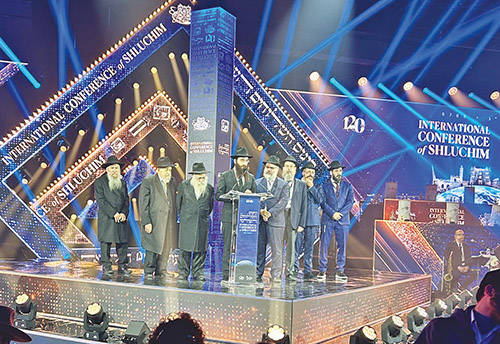
We learn in the Gemara (Sukkah 51a) that “Whoever has not seen this celebration [the Simchas Bais HaSho’eva, in the Beit Hamikdash] never saw a celebration in his life.”
This reporter can tell you, having witnessed this massive event on Sunday, November 20, in the New Jersey Convention and Exposition Center in Edison, that “Whoever has not seen the Chabad-Lubavitch Kinus HaShluchim Haolomi has not seen a gathering of thousands of dedicated Jewish leaders, assembled for inspiration, achdut (unity) and celebration of their mission.” Nothing can compare to this awesome assemblage.
The Kinus HaShluchim was part of the International Conference of Chabad-Lubavitch Emissaries, held November 17-21—a five-day event filled with workshops, Torah study, networking opportunities, a visit to the Rebbe’s resting place in Old Montefiore Cemetery, a massive Chabad Shluchim “Class Picture” in front of Chabad-Lubavitch Worldwide Headquarters (770 Eastern Parkway, Crown Heights), and other activities for the 6,500 Chabad-Lubavitch shluchim (emissaries) and lay leaders who attended. Participants came from more than 100 countries and territories around the world for the first post-pandemic conference.

The Kinus HaShluchim on Sunday, November 20, was an elaborate sit-down dinner, with a full program, that brought the conference attendees under one roof in the New Jersey Convention and Exposition Center, since (as Chabad reported) the gathering has outgrown New York City venues. The Kinus featured a dazzling center stage, multiple television monitors throughout the building and elaborate video presentations that accompanied different aspects of the program.
The event began with a recitation of a few paragraphs of Tehillim, followed by an address in Hebrew by Rabbi Dovid Lau, Ashkenazi Chief Rabbi of Israel. Rabbi Lau spoke of the power of the Rebbe’s vision, which has reached all corners of the world. He described Chabad-Lubavitch’s work as “unprecedented,” having a lasting impact on the world and reflecting the passion of the shluchim.
Rabbi Avraham Feldman, the Chabad-Lubavitch shliach in Reykjavik, Iceland and Rabbi Levi Mochkin, a third-generation Shluach serving in Palo Alto, California—his father served as Shluach in Rochester, New York, and his grandfather served as Shluach in Montreal, Canada—shared their perspectives on the work of shluchim in different environments.
The keynote speaker was George Rohr of New York City, a successful businessman who generously supports the work of Chabad-Lubavitch, following in the footsteps of his father Sammy Rohr, zt”l, who was quite close to the Lubavitcher Rebbe, zt”l. Rohr told the appreciative crowd that in terms of ROI (return on investment), “Chabad offers the best bang for your buck, because the shluchim’s level of Mesiras Nefesh (personal sacrifice) exceeds everything. In the business world, if you’re considering investing in a business, you look at the level of dedication of the business leaders. Our shluchim have all their skin in the game. For them, failure is not an option.” Rohr went on to share two moving stories of shluchim who reached young unaffiliated Jews, and of two young Jews who became connected to their religion then took roles to serve the Jewish community.

Rohr noted that in 1994, at the Rebbe’s passing, Chabad-Lubavitch had 1,200 shluchim at 300 Chabad institutions. Commentators thought that, as the Rebbe was no longer the guiding force, the Chabad network might slowly dissolve. Yet now, there are over 5,000 shluchim couples serving in more than 3,000 Chabad institutions, and 244 Chabad Houses on college campuses.
“Nothing in Jewish history remotely compares to the Rebbe’s army.”
The program continued with remarks by “Ambassador of Light” Rabbi Yechiel Shlomo Levitansky, the shliach in Sumy, Ukraine, about the current challenges in his work, followed by the International Roll Call of all Chabad-Lubavitch institutions across the world. The program concluded with a historic siyum, celebrating the dedication of 36 sifrei Torah that will be sent to different Chabad communities around the world, accompanied by the lively Chasidic dancing that is one of the calling cards of Chabad.
Asked what he felt was the compelling aspect of the Kinus, Rabbi Shneor Segal, shliach in Baku, Azerbaijan, said: “This is the biggest gathering in one room of Jews from around the world. Being together, we feel as one family, which inspires us to keep finding another Jew, and another Jew, and bringing them closer to yiddishkeit.”

Rabbi Menachem Hartman, shliach in Ho Chi Minh City, Vietnam, shared: “Being together with other Shalichim from all over the world gives us chizuk (strength) to continue our mission.”
Rabbi Yossi Harling, shliach in Kendall, Florida, who served as a chaplain for the Miami-Dade Police Department at the Surfside tragedy, said: “Just seeing all the Chabad-Lubavitch rabbis from all over the world, especially those in small towns, without much infrastructure, who are all there because of the Rebbe’s vision—this inspires me to go back home and continue to do my work.”
Rabbi Shmuel Metzker, shliach at Sutton Place, Manhattan, stated: “This room represents all the Jewish people, in all 50 states, and in 100 countries. It demonstrates the unity of the Jewish people.”
Rabbi Joseph Telushkin of New York, a noted author who published a well-regarded book on the Lubavitcher Rebbe, said: “The intensity of the dedication of the shluchim is remarkable. Many people, in many professions, are dedicated. These people are dedicated 24/7. They truly believe that each person is created in the image of Hashem, and it’s their honor to assist them.”

As you can tell, Harry Glazer was awed by the Kinus Hashluchim. He welcomes news tips about other notable Jewish communal events. He can be reached at harryglazer615@gmail.com
By Harry Glazer












